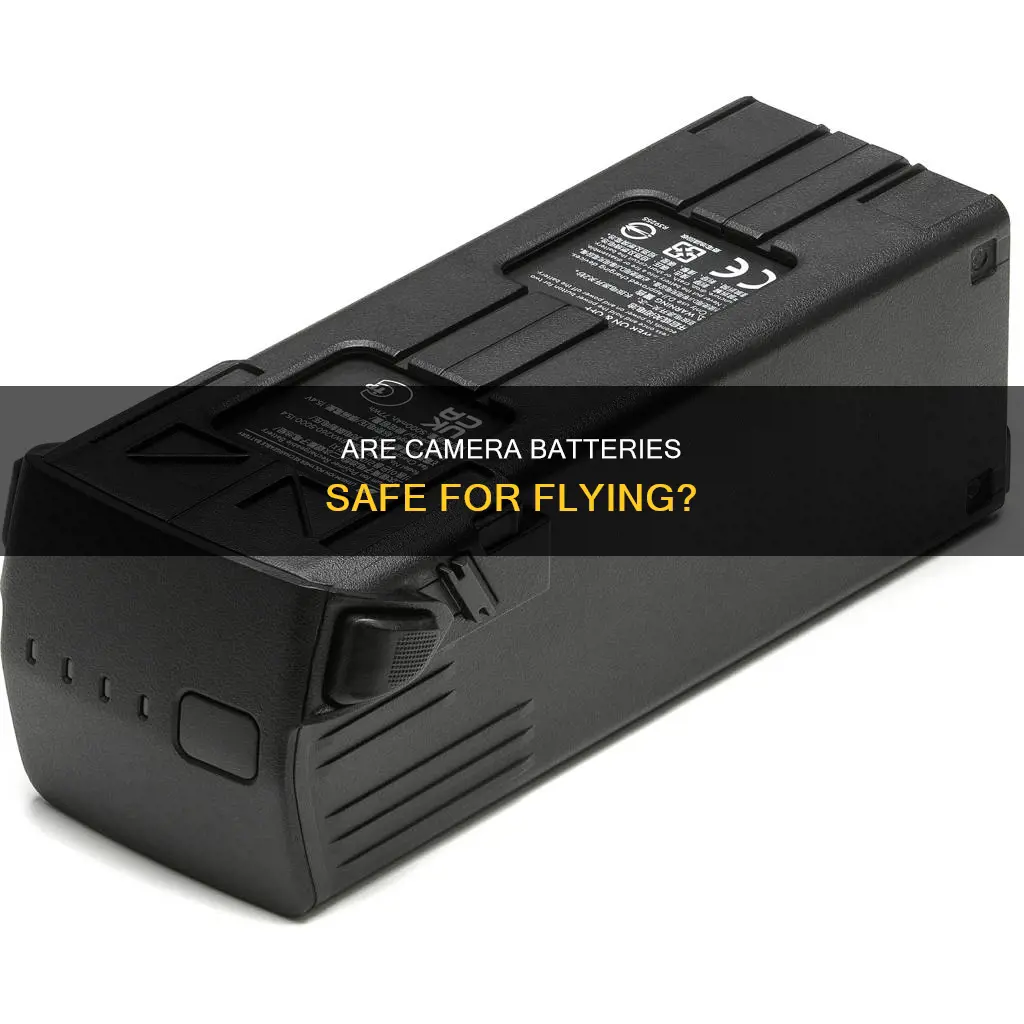
Camera batteries are almost always lithium-ion batteries, which are considered a hazardous material by the Federal Aviation Administration (FAA). As a result, there are strict guidelines for carrying them on airplanes. The FAA and the Transportation Security Administration (TSA) advise that devices with installed lithium-ion batteries, such as cameras, should be kept in carry-on baggage. If these devices must be placed in checked baggage, they should be turned off, protected from accidental activation, and packed securely to prevent damage. Spare lithium-ion batteries, on the other hand, are prohibited in checked baggage and must be carried in carry-on luggage. This is because a fire in the cabin can be addressed, whereas a fire in the cargo hold is much more dangerous.
| Characteristics | Values |
|---|---|
| Type of battery | Lithium-ion |
| Devices that use this battery type | Cameras, smartphones, laptops, tablets, etc. |
| Battery location | Should be kept in carry-on baggage |
| Battery quantity | No restriction on the number of small dry-cell batteries; a maximum of two spare lithium-ion batteries |
| Battery capacity | Under 100Wh: allowed; 101-160Wh: allowed with airline approval; Over 160Wh: not allowed |
| Battery condition | No damage, swelling, or leakage |
| Battery packaging | Use original packaging or tape to cover terminals; place in separate bags |
| Battery transportation | Carry-on baggage only |
What You'll Learn

Lithium-ion batteries are hazardous
The safe disposal of lithium-ion batteries is also a concern. Even when no longer useful in consumer equipment, lithium-ion batteries pose a fire hazard. Used lithium-ion batteries should be recycled at certified battery electronics recyclers rather than being discarded in the trash or municipal recycling bins. To prevent fires during transportation and disposal, it is recommended to tape battery terminals and/or place lithium-ion batteries in separate plastic bags.
Overall, while lithium-ion batteries have revolutionized portable electronics, their hazardous nature cannot be overlooked. The high energy density that makes them so valuable also poses safety risks that must be carefully managed to prevent accidents and incidents.
Charging Your Fujifilm Camera Battery: How Long Does It Take?
You may want to see also

Keep batteries in carry-on luggage
Keeping batteries in your carry-on luggage is generally recommended, and in some cases, required. The Federal Aviation Administration (FAA) states that devices containing lithium-ion batteries, including smartphones, tablets, cameras, and laptops, should be kept in carry-on baggage. This is because, in the cabin, airline flight crews can better monitor conditions and address any potential fire hazards.
The FAA has set specific limits for lithium batteries on airplanes. Lithium metal batteries are limited to 2 grams of lithium per battery, while lithium-ion batteries are limited to 100-watt hours per battery. These limits cover most lithium batteries used in everyday electronic devices, including camera batteries. With airline approval, passengers can carry up to two larger lithium-ion batteries (101-160 Wh) or lithium metal batteries (2-8 grams).
It is important to note that uninstalled or spare lithium-ion batteries must be carried in carry-on baggage. This is because loose lithium batteries in the cargo hold can pose a fire hazard without anyone available to intervene and stop the fire. To prevent short circuits, protect the battery terminals by using the manufacturer's packaging or covering the terminals with tape. It is also recommended to place the batteries in separate bags to ensure further protection.
In addition to lithium-ion batteries, dry cell alkaline batteries (AA, AAA, C, D, 9-volt, etc.) and dry cell rechargeable batteries (Nickel Metal Hydride and Nickel Cadmium) are also allowed in carry-on bags. There are no quantity restrictions on these types of batteries.
When packing batteries for air travel, it is important to follow safety guidelines. If you are traveling with spare batteries, place each battery in its own protective case, plastic bag, or package, or cover the battery's contacts with tape to isolate the terminals and prevent hazards due to short-circuiting. Additionally, if you are carrying a battery-powered device, package it so that it cannot accidentally turn on during the flight.
Charging the WASP 4K Camera: A Step-by-Step Guide
You may want to see also

Tape battery terminals
When flying with camera equipment, it's important to be aware of the regulations surrounding lithium-ion batteries. These batteries are commonly found in camera equipment and have specific rules due to their potential for rapid combustion. While installed lithium-ion batteries inside cameras are generally considered safe, there are guidelines to follow when packing spare batteries.
To prevent short circuits, it is crucial to protect the battery terminals. This can be done by taping the terminals or using the manufacturer's packaging. Clear sticky tape should be used to cover all exposed metal parts of the battery terminals. This will help to prevent sparks and fires if the battery terminals come into contact with other metal objects. It is also recommended to place the batteries in separate bags to ensure further protection.
When preparing for air travel, it is important to tape the battery terminals of your camera batteries. This will help to prevent short circuits and fires during transportation. You should use clear sticky tape to cover all exposed metal parts of the terminals. Make sure the tape is secure and that there is no risk of the metal terminals being exposed.
In addition to taping the terminals, there are a few other precautions to take when travelling with camera batteries. First, it is recommended to carry them in your carry-on baggage instead of checking them in. This is because loose lithium batteries in the cargo hold can pose a fire hazard without anyone available to intervene. Second, make sure the batteries are not damaged in any way, as damaged batteries can be dangerous. Finally, be mindful of any weight or quantity restrictions imposed by the airline or aviation authorities.
By following these guidelines, you can help ensure the safe transportation of your camera batteries and have a worry-free trip.
Simplisafe Outdoor Camera: Charging Frequency Explained
You may want to see also

Weight limits
If you know you will exceed the weight limit, it's often cheaper to book and pay for excess baggage ahead of time rather than at the airport.
Regarding lithium-ion camera batteries, there are specific weight/watt-hour restrictions in place. Lithium-ion batteries under 100 watt-hours (Wh) can be carried on or checked in without restriction. For lithium-ion batteries over 100 Wh but under 160 Wh, you will need airline approval, and these batteries must be carried on and cannot be checked in. The limit is two spare lithium-ion camera batteries per person in this higher watt-hour range.
It's worth noting that lithium-ion batteries are considered dangerous goods due to their potential to short-circuit or catch fire. Therefore, it's essential to take precautions when packing them, such as taping over the charging interface or contacts to prevent short circuits.
Charging Your Bird Buddy Camera: A Quick Guide
You may want to see also

Battery charging equipment
When it comes to flying with camera equipment, it's important to keep your gear safe and secure, and this includes your battery charging equipment. Here are some detailed instructions and considerations for packing and preparing your battery charging equipment for air travel:
- AC chargers: These chargers connect directly to an electrical outlet and are typically used for charging batteries outside of the camera. They usually have a compact design and are easy to carry.
- USB-powered chargers: These chargers are powered by USB ports, making them convenient for travel as they can be connected to laptops, power banks, or other USB power sources.
- Dual battery chargers: These chargers allow you to charge two batteries simultaneously, which can be useful when you need to charge multiple batteries quickly.
- Battery charging kits: These kits often include a charger and additional batteries, providing a complete solution for your power needs.
Packing and Preparing Battery Charging Equipment for Air Travel
When packing and preparing your battery charging equipment for air travel, keep the following in mind:
- Carry-on luggage: It is recommended to pack your battery charging equipment in your carry-on luggage. This allows you to keep an eye on your equipment and ensures that it is not subjected to extreme temperatures or pressure changes in the cargo hold.
- Protective cases: Use protective cases or the original packaging to store your battery charging equipment. This will shield your chargers from potential damage and prevent them from accidentally turning on.
- Tape battery terminals: To prevent short circuits, cover the battery terminals with tape. This can be done using camera tape, which won't leave any sticky residue, or by using the manufacturer's provided packaging.
- Separate bags: For added safety, place each battery and charger in separate bags. This ensures that if one battery experiences a malfunction, it won't affect the others.
- Weight and size restrictions: Be mindful of the weight and size restrictions for carry-on luggage. Excess baggage can be expensive, so consider distributing your equipment across multiple bags or carrying some items in your jacket pockets.
- International regulations: Research the regulations of the country you are travelling to. Some countries have specific rules regarding the number of cameras and batteries you can bring, and you may need to declare your equipment or provide proper documentation.
- Customs declaration: In most cases, you won't need to declare camera equipment to customs officers. However, if you are travelling with video equipment, you may be seen as a commercial media operation and may need to provide additional information.
- Insurance: Consider insuring your camera equipment, especially if you are travelling with valuable gear. This will provide peace of mind in case of loss or damage during transit.
By following these guidelines, you can ensure that your battery charging equipment is properly prepared and packed for air travel, allowing you to focus on capturing memorable moments during your trip.
The Ultimate Camera Companion: DE-A93 Battery Charger
You may want to see also
Frequently asked questions
Yes, camera batteries are allowed on planes, but there are some specific rules to follow.
Lithium-ion camera batteries are considered hazardous materials due to their potential to short-circuit or catch fire. These batteries should be carried in your hand luggage and must be protected from damage and short circuits. Each passenger is limited to two spare lithium-ion camera batteries, and the watt-hour rating of the battery should be below 100 Wh.
Devices with installed lithium-ion batteries, such as cameras, smartphones, laptops, and tablets, are generally considered safe and should be kept in carry-on baggage. If these devices must be placed in checked baggage, they should be turned off, protected from accidental activation, and packed to prevent damage.
Yes, you can purchase camera bags that comply with airline carry-on restrictions. These bags allow you to keep your camera and necessary batteries with you. Additionally, you can use cable ties instead of padlocks to secure your camera equipment, making it less appealing to potential thieves.







